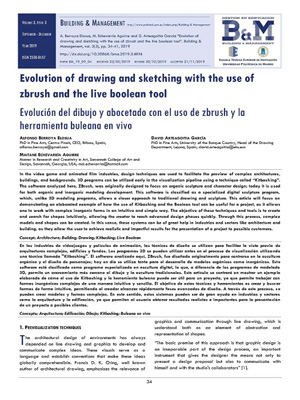
Evolution of drawing and sketching with the use of zbrush and the live boolean tool = Evolución del dibujo y abocetado con el uso de zbrush y la herramienta buleana en vivo
DOI: https://doi.org/10.20868/bma.2019.3.4034
Texto completo:
PDF (English)Resumen
In the video game and animated film industries, design techniques are used to facilitate the preview of complex architectures, buildings, and backgrounds. 3D programs can be utilized early in the visualization pipeline using a technique called “Kitbashing”. The software analyzed here, ZBrush, was originally designed to focus on organic sculpture and character design; today it is used for both organic and inorganic modeling development. This software is classified as a specialized digital sculpture program, which, unlike 3D modeling programs, allows a closer approach to traditional drawing and sculpture. This article will focus on demonstrating an elaborated example of how the use of Kitbashing and the Boolean tool can be useful for a project, as it allows one to work with complex inorganic forms in an intuitive and simple way. The objective of these techniques and tools is to create and search for shapes intuitively, allowing the creator to reach advanced design phases quickly. Through this process, complex models and shapes can be created. In this sense, these systems can be of great help in industries and sectors like architecture and building, as they allow the user to achieve realistic and impactful results for the presentation of a project to possible customers.
Resumen
En las industrias de videojuegos y películas de animación, las técnicas de diseño se utilizan para facilitar la vista previa de arquitecturas complejas, edificios y fondos. Los programas 3D se pueden utilizar antes en el proceso de visualización utilizando una técnica llamada "Kitbashing". El software analizado aquí, ZBrush, fue diseñado originalmente para centrarse en la escultura orgánica y el diseño de personajes; hoy en día se utiliza tanto para el desarrollo de modelos orgánicos como inorgánicos. Este software está clasificado como programa especializado en escultura digital, lo que, a diferencia de los programas de modelado 3D, permite un acercamiento más cercano al dibujo y la escultura tradicionales. Este artículo se centrará en mostrar un ejemplo elaborado de cómo el uso de Kitbashing y la herramienta buleana puede ser útil para un proyecto, ya que permite trabajar con formas inorgánicas complejas de una manera intuitiva y sencilla. El objetivo de estas técnicas y herramientas es crear y buscar formas de forma intuitiva, permitiendo al creador alcanzar rápidamente fases avanzadas de diseño. A través de este proceso, se pueden crear modelos y formas complejas. En este sentido, estos sistemas pueden ser de gran ayuda en industrias y sectores como la arquitectura y la edificación, ya que permiten al usuario obtener resultados realistas e impactantes para la presentación de un proyecto a posibles clientes.
Palabras clave
Referencias
F. D. K.Ching, “Manual de dibujo arquitectónico”, Editorial Gustavo Gili, S.L., Barcelona, 2016.
S. Robertson, “How to Draw: Drawing and Sketching Objects and Environments from your Imagination”, Design Studio Press, Los Angeles, 2013.
J. Alcaide-Marzal, J. A. Diego-Más, S. Asensio-Cuesta, and B. Piqueras-Fiszman, “An exploratory study on the use of digital sculpting in conceptual product design”, Design Studies, Vol. 34, No. 2, pages 264-286, March 2013.
A. Berroya Elosua, and M. Echevarria Aguirre, "Architectural drawing, concept art and environment art as new techniques and processes to represent spaces for cinema and videogames", XIV Congreso Internacional de Expresión Gráfica aplicada a la Edificación, APEGA 2019, De la línea a la nube, Seville, February 2019.
A. Denker, “3D visualization and photo-realistic reconstruction of the Great Temple of Bel”, The International Archives of the Photogrammetry, Remote Sensing and Spatial Information Sciences, Volume XLII-2/W3, 2017 3D Virtual Reconstruction and Visualization of Complex Architectures, Greece, March 2017.
M. Peng, J. Xing, and L. Wei, "Autocomplete 3D Sculpting", ACM Trans. Graph., Vol. 37, No. 4, Article 132, August 2018.
A. Gahan, “3DS Max Modeling for Fames”, Routledge, New York, 2012.
A. Loomis, “Creative Illustration”, The Viking Press, New York, 1947.
A. Rob, “How to Draw and Paint Fantasy Architecture”, Barron’s Educational Series Inc., New York, 2011.
F. Cowan, “Dibujar y Pintar Mundos de Fantasía”, Evergreen, 2006.
G. Russel, “El Arte de la Comunidad Del Anillo”, Ediciones Minotauro S.A., Barcelona, 2002.
J-C. Park, “The Art of Paper Blue”, Design Studio Press, Higuera City, 2014.
M. Brehm, “Dibujo De La Perspectiva, Cómo Verla, Cómo aplicarla”, Barcelona, Promopress, 2016.
M. Lewis, and M. Lewis, “Beginner’s Guide to ZBrush”, 3DTotal Publishing, Worcester, 2017.
M. Mckenna, “Digital Fantasy Painting Workshop”, The Ilex Press limited, 2004.
O. Demers, “Texturing & Painting”, New Riders, San Francisco, 2002.
R. Alexander, “Cómo dibujar y pintar arquitectura de fantasía”, Norma Editorial, Barcelona, 2012.
S. Robertson, and T. Bertling, “How to render: The Fundamentals of Light, Shadow and Reflectivity”, Design Studio Press, Los Angeles, 2014.
VVAA, “Concept Design 2: Works from Seven Los Angeles Entertainment Designers and Guest Designers”, Design Studio Press, Higuera City, 2005.
VVAA, “Taller de Fantasía Digital”, Norma Editorial SA., Barcelona, 2009.
VVAA “Blast, Spaceship Sketches and Renderings”, Design Studio Press, Higuera City, 2012.
W. Stanchfield, “Drawn to Life”, Focal Press, Oxon, 2009.
W. Yin, “Impeccable Scene Design for Game, Animation and Film”, Gingko Press Inc., Berkeley, 2010.
Enlaces refback
- No hay ningún enlace refback.
Copyright (c) 2019 Autor / BY-NC-ND

Este obra está bajo una licencia de Creative Commons Reconocimiento-NoComercial-SinObraDerivada 4.0 Internacional.










